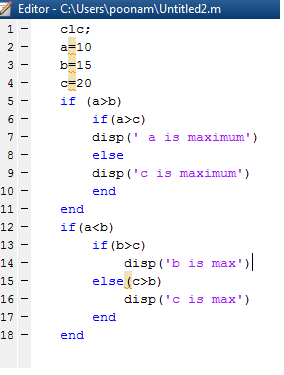

Python is younger but has since matured into a product which out-performs Matlab in many fields. A commercial product called Matlab is also used extensively and has a long(er) history in both engineering and science.
MATLAB VS PYTHON IF STATEMENTS HOW TO
The flexibility and adaptability of Python make it a virtual Swiss-army pocket knife and extremely productive and useful to those who know how to wield this awesome piece of kit. Like the slide-rule and calculator from the past, a good working knowledge of Python should be considered an essential part of the engineer or scientists arsenal of skills.

An efficient way to utilise and exploit this power is the Python programming language. Nowadays computers or even smartphones, pack unheard of computing power available at our fingertips. Over time simple log and sine tables have been replaced by slide-rules and calculators. IntroductionĮngineers and scientists alike have had many tools at their disposal to assist them in performing the various calculations needed to do their job. In fact this memo argues the position that especially for new (non-legacy) applications Python is the best choice to accomplish the job.

This memo tries to explain some of the differences an highlight the advantages that Python has over Matlab. Both are used extensively but differ in some elementary ways. Python and Matlab are both tools that can be used to execute various data analysis and rendering tasks both in science and engineering. Based on own experience and references at the end of this post. Hence we have to be very careful to ensure correct indentation of the code! Below we use the function `sqrt()` from numpy.Arguments for using Python for science and engineering (instead of some other tool like Matlab).
MATLAB VS PYTHON IF STATEMENTS CODE
However, there is no `end` statement in Python: Python treats everything that is indented following the `:` as part of the loop, and ends at the next unindented code block. The colon `:` signifies the start of the loop. Notice also that the ordering differs between Matlab and Python!Ī for-loop in python is also started using `for`, and the counter set to be `in` the iteration array. However, if you use choose `stop=-1`, the last element of the array will not be included. A range of values can be accessed by using `start:stop:step`, where `start` denotes the first index, `step` the step between indexes, and `stop` the last index to be included. However, Python uses `` to access an element of an array, and the index `0` accesses the first element of the array! Backwards indexing is also possible, where the last element can be accessed by using using the index `-1`. Theta0 = theta0 * pi / 180 # Convert throwing angle to radians x = 0 # Define starting position, x direction y = 0 # Define starting position, y direction u = v0 * cos ( theta0 ) # Initial velocity in x-direction w = v0 * sin ( theta0 ) # Initial velocity in y-direction However, indentation helps keeping the code readable. Matlab will not care about indentation inside the loop, but treats everything between for and end as inside the loop. The loop has to be ended with an end statement. In Matlab a for-loop is started using for and setting a counter equal to the array that is to be iterated over. We now use Euler's method to solve the equations of motion in time. A range of values can be accessed by using start:step:stop, where start denotes the first index, step the step between indexes, and stop the last index to be included. The last element can be accessed by using using the index end. We see that Matlab uses () to access an element of an array, and the index 1 accesses the first element of the array. Theta0 = theta0 * pi / 180 % Convert throwing angle to radians x ( 1 ) = 0 % Define starting position, x direction y ( 1 ) = 0 % Define starting position, y direction u ( 1 ) = v0 * cos ( theta0 ) % Initial velocity in x-direction w ( 1 ) = v0 * sin ( theta0 ) % Initial velocity in y-direction


 0 kommentar(er)
0 kommentar(er)
